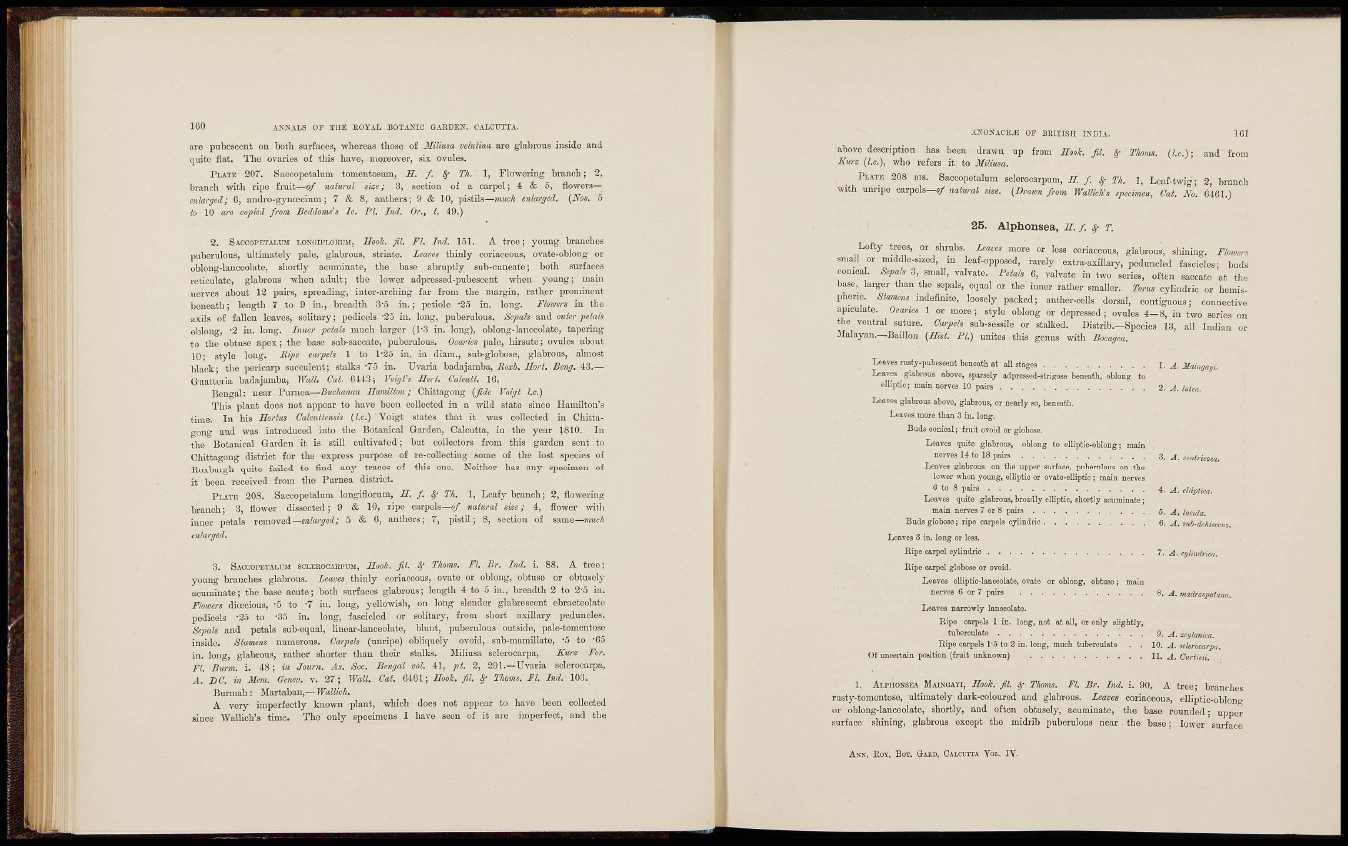
160 ANNALS OF THE EOYAL BOTANIC GARDEN, CALCUTTA.
are pubescent on both surfaces, -whoreas those of MiUusa velutina are glabrous inside and
quite flat. The ovaries of this have, moreover, sis ovules.
PLATE 207. Saccopctalum tomentosum, E. f. Th. 1, Flowering branch; 2,
branch with ripo fi-uit—of natural size; 3, section of a carpel; 4 & 6, flowers—
enlarged; 6, andro-gynascium; 7 & 8, anthers; 9 & 10, pistils—»«icA enlarged. (JS'os. 5
to 10 are copied front Beddome's Ic. PI. Ind. Or., t. 49.)
2. SACCOPETALUM LONGIFLOKUM. Hook. fil. Fl. Ind. 151. A tree; young branches
pubei'ulous, ultimately pale, glabrous, striate. Leaves thinly coriaceous, ovate-oblong or
obloug-lauceolate, shortly acuminate, the base abruptly sub-cuneato; both surfaces
reticulate, glabrous when adult; the lower adpressed-pubesccnt when young; main
nerves about 12 pairs, spreading, inter-arching far from the margin, rather prominent
beneath; length 7 to 9 in., breadth 3-5 in.; petiole -25 in. long. Floioers in the
axils of fallen leaves, solitary; pedicels -25 in. long, puberulous. Sepals and outer petals
oblong, "2 in. long. Inner petals much larger (1-3 in. long), oblong-lanceolate, tapering
to the obtuse apex; the base sab-saccate, puberulous. Ooarics pale, hirsute; ovules about
10; style long. Ri^Je carpels 1 to 1-25 in. in diam., sub-globose, glabrous, almost
black; the pericarp succulent; stalks '75 in. Uvaria badajamba, Roxb. Uort. Beng. 43.—
Guatteria badajamba. Wall Cat. 0443; Voigfs Hort. Caleutt. 16.
Bengal: near Puniea—Buchanan Hamilton; Chittagong [fide Voigt I.e.)
This plant does not appear to have been collected in a wild state since Hamilton's
time. In his Hortus Calcuttehsis {I.e.) Voigt states that it was collected in Cliittagong
and was introduced into the Botanical Garden, Calcutta, in the year 1810. In
the Botanical Garden it is still cultivated; but collectors from this garden scut to
Chittagong district for the express purpose of re-collecting some of the lost species of
Roxburgh quite failed to find any traces of this one. Neither has any specimen of
it been received from the Purnea district.
PLATE 208. Saccopetalum longiflorum, H. f. ^ Th. 1, L e a f y branch; 2, flowering
branch; 3, flower dissected; 9 & 10, ripe carpels—o/ natural sise; 4, flower with
inner petals removed—sjite-^ret?; 5 & 6, anthers; 7, pistil; 8, section of same—imich
3. SACCOPETALUM SCLEEOCAEPUM, HOOJC. fil. ^ Thms. Fl. Br. Ind. i. 88. A tree;
young branches glabrous. Leaves thinly coriaceous, ovate or oblong, obtuse or obtuseljacuminate;
the base acute; both surfaces glabrous; length 4 to 5 in., breadth 2 to 2-5 in.
Flozoers dicecious, -5 to -7 in. long, yellowish, on long slender glabrescent ebracteolate
pedicels -25 to '35 in. long, fascicled or solitary, from short axillary peduncles.
Sepals and petals sub-equal, linear-lanceolate, blunt, puberulous outside, pale-tomentose
inside. Stamens numerous. Carpels (unripe) obliquely ovoid, sub-mamillate, -5 to 'Co
in. long, glabrous, rather shorter than their stalks. Miliusa sclerocarpa, Kurz For.
Fl. Burm. i. 48; in Journ. As. Soo. Bengal vol. 41, pi. 2, 291.—Uvaria sclerocarpa,
A. DC. in Mem. Gene v. v. 2 7 ; Wall. Cat. 6481; Hoo/c. fl. ^ Thorns. Fl. Ind. 103.
Burmah: Martaban,—irrtZZw/i.
A very imperfectly known plant, which does not appear to have boon collected
since "Wallich's time. The only specimens I have seen of it are imperfect, and the
-Uv-ONACE^ OF BEITISH INDIA.
above description has been drawn up from HooL fil. ^ T/wm-i. (I.e.); and from
Kurz (I.e.), who refers it to Miliusa.
PLATE 208 BIS. Saccopetalum sclerocarpum, IL f . ^ Th. I, Leaf-twig; 2, branch
with unripe carpels—o/ natural size. {Drawn from Wallich's specimen, Cat. No. 6401.)
2 5 . A l p h o n s e a , H. f . ^ T.
L o f t y h'ees, or shmbs. Leaves more or less coriaceous, glabrous, sliining. Flowers
sn.all or middle-sized, in leaf-opposed, rarely extra-axillary, peduncled fascicles; buds
conical. SepaU 3, small, valvate. Petals 6, valvate in two series, often saccatc at the
base, larger than the sepals, equal or the inner rather smaller. Torus cylindric or hemispheric.
Stamens indefinite, loosely packed; anther-cells dorsal, contiguous; connective
apiculate. Ovaries 1 or more; style oblong or depressed; ovules 4 - 8 , in two series on
the ventral suture. Curpels sub-sessile or stalked. Distrib.—Species 13, all Indian or
Jlalayan.—Bâillon {Hkt. PL) unites this genus with Bocagea.
Leaves rusty-pubesoent beneath at all stages 1. A. Maingayi.
Leaves glabrous above, sparsely adpressed-strigose beneatb, oblong to
elliptic; main nerves 10 pairs 2. A latea
Leaves glabrous above, glabrous, or nearly so, beneath.
Leaves more than 3 in. long.
Buds conical; fruit ovoid or globose.
Leaves quite glabrous, oblong to elliptic-oblong; main
nerves 14 to 18 pairs 3. j . eenlncosa.
Leaves glabrous on the upper surface, puberulous on the
lower when young, elliptio or ovate-elliptic ; main nerves
6 to 8 paü-3 A. duplica.
Leaves qxiite glabrous, broadly elliptic, shortly acuminate ;
main nerves 7 or 8 pairs 5. Imida.
Buds globose; ripe carpels cylindric A. mb-dehiscens.
Leaves 3 in. long or less.
Ripe carpel cylindric 7. A. cylindrica.
Ripe carpel globose or ovoid.
Leaves elliptic-lanceolate, ovato or oblong, obtuse ; main
nerves 6 or 7 pairs 8. madraapaiana.
LeavM narrowly lanoeolate.
Ripe carpels 1 in. long, not at all, or only slightly,
tuberculate ! . . 9. zeylanica.
Eipe carpels 1-5 to 3 in. long, much tuberculate . . 10. A. sclerocarpa.
Of uncertain position (fruit unknown) 11. .,4. Curtinii.
1. ALPHONSEA MAINGAYI, Hook. fil. ^ Thorns. Fl. Br. Ind. i. 90. A tree; branches
rusty-tomentoso, ultimately dark-coloured and glabrous. Leaves coriaceous, elliptic-oblong
or oblong-lanceolate, shortly, and often obtusely, acuminate, the base rounded; upper
surface shining, glabrous except the midrib puberulous near the base; lower surface
ANN. EO-Ï. BOT. GAUD. CALCITTA YOL. I Y.